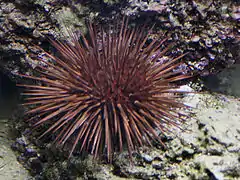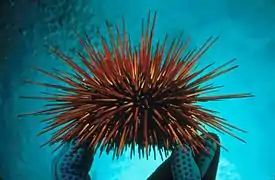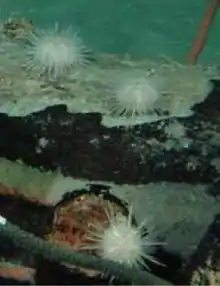Camarodonta
The Camarodonta are an order of globular sea urchins in the class Echinoidea. The fossil record shows that camarodonts have been in existence since the Lower Cretaceous.[2]
| Camarodonta | |
|---|---|
 | |
| Paracentrotus lividus | |
| Scientific classification | |
| Kingdom: | Animalia |
| Phylum: | Echinodermata |
| Class: | Echinoidea |
| Superorder: | Echinacea |
| Order: | Camarodonta Jackson, 1912 [1] |
| Families | |
|
| |
Characteristics
All camarodonts have imperforate tubercles and compound ambulacral plates with the lowest elements enlarged. The pores are at regular intervals along the ambulacral plates from the apex to the mouth opening or peristome. The Aristotle's lantern, or jaw system, has keeled teeth with the supports meeting above the "foramen magnum".[2]
Families
According to World Register of Marine Species:[1]
- Infraorder Echinidea (Kroh & Smith, 2010)
- Family Echinidae (Gray, 1825)
- Superfamily Odontophora (Kroh & Smith, 2010)
- Family Echinometridae (Gray, 1855)
- Family Strongylocentrotidae (Gregory, 1900)
- Family Toxopneustidae (Troschel, 1872)
- Family Parechinidae (Mortensen, 1903b)
- Family Parasaleniidae (Mortensen, 1903b)
- Infraorder Temnopleuridea (Kroh & Smith, 2010)
- Family Temnopleuridae (A. Agassiz, 1872)
- Family Trigonocidaridae (Mortensen, 1903b)



_edit.jpg.webp)

 Parasalenia poehlii, Parasaleniidae
Parasalenia poehlii, Parasaleniidae Microcyphus rousseaui, Temnopleuridae
Microcyphus rousseaui, Temnopleuridae Asterechinus elegans, Trigonocidaridae
Asterechinus elegans, Trigonocidaridae
References
- Camarodonta World Register of Marine Species. Retrieved 2011-08-27.
- The Echinoid Directory The Natural History Museum. Retrieved 2011-08-27.
This article is issued from Wikipedia. The text is licensed under Creative Commons - Attribution - Sharealike. Additional terms may apply for the media files.